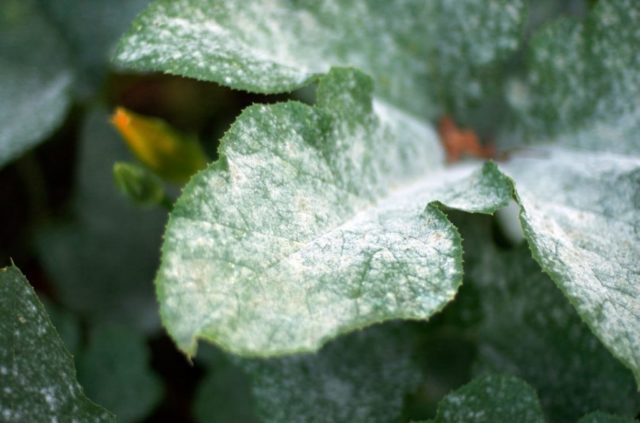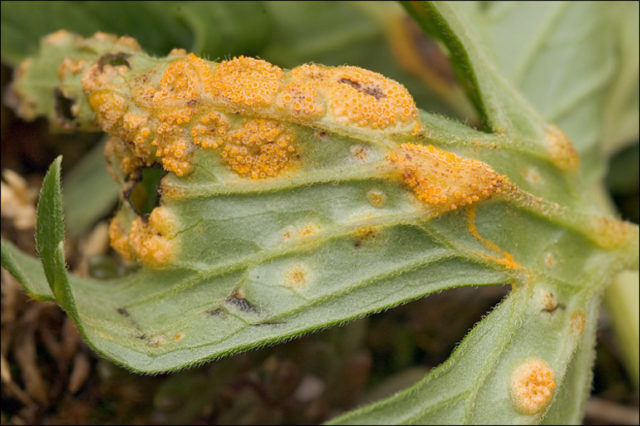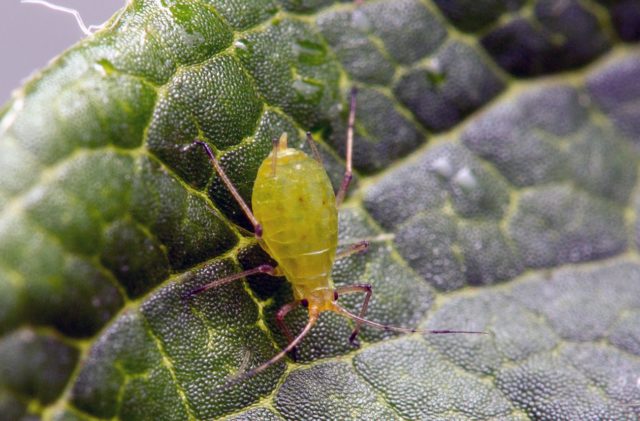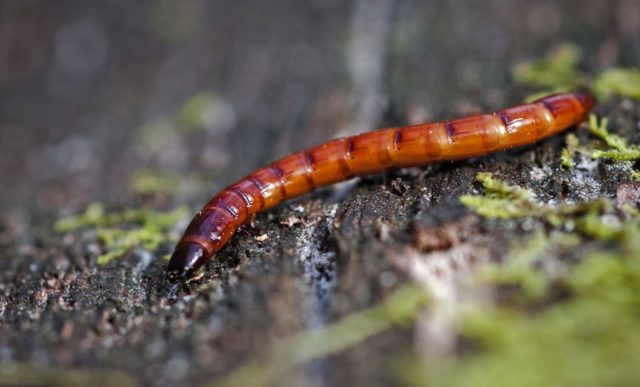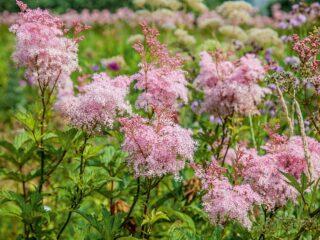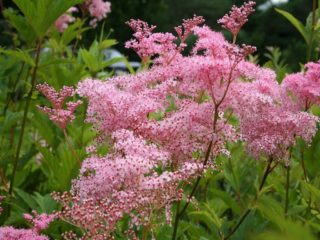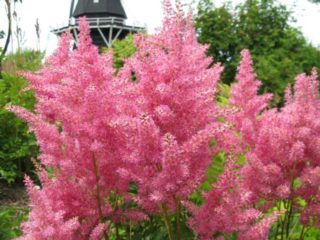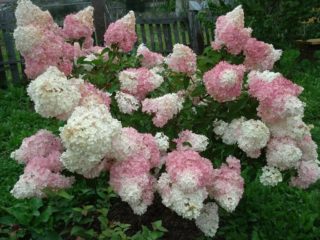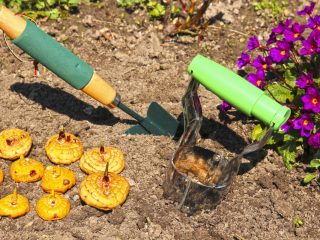Content
Pink meadowsweet is a popular decorative perennial belonging to the species of elm-leaved meadowsweet (F. ulmaria). The scientific name Filipendula rosea in literal translation sounds like "hanging threads". The root system of meadowsweet consists of numerous small nodules hanging on threadlike roots (hence the name of the plant). The people call the meadowsweet a tavolzhnik, a medushnik for its exceptional melliferous qualities. During flowering, the plant exudes a dizzying, sweet aroma, and attracts many insects. The culture is a hybrid of pink-flowered meadowsweet species grown outdoors. The meadowsweet is considered one of the most unpretentious garden giants.

Beautifully blooming meadowsweet - ideal landscape decor
Description and characteristics
Moisture-loving meadowsweet (meadowsweet) prefers well-moistened, loose soil. Under favorable conditions, the plant grows rapidly, forms dense thickets. Garden pink meadowsweet is characterized by the following features:
- the root system is short, fibrous, creeping, with filamentous processes and nodules;
- bush height up to 1.5 m;
- stems are erect, smooth, leafy, tough;
- leaves are large, intermittently pinnate;
- leaf color: top - dark green, underside - white-felt;
- peduncles are long, strong, erect;
- the number of inflorescences on one shoot up to 8 pieces;
- inflorescences are voluminous, paniculate, dense, with numerous small flowers;
- inflorescence length up to 15 cm;
- flowers are bisexual, five-petal, with long stamens;
- flower diameter up to 1 cm;
- the color of the inflorescences is pink;
- the aroma is pleasant, vanilla-honey, delicate;
- flowering period - from July to August;
- the fruit is a spiral multileaf.
In hot, dry weather, the leaves of the rose-colored meadowsweet (meadowsweet) temporarily dry out, protecting the bush from a critical loss of natural moisture. The plant prefers well-lit, abundantly moist areas with loose, permeable soil. In the shade, meadowsweet practically does not bloom.
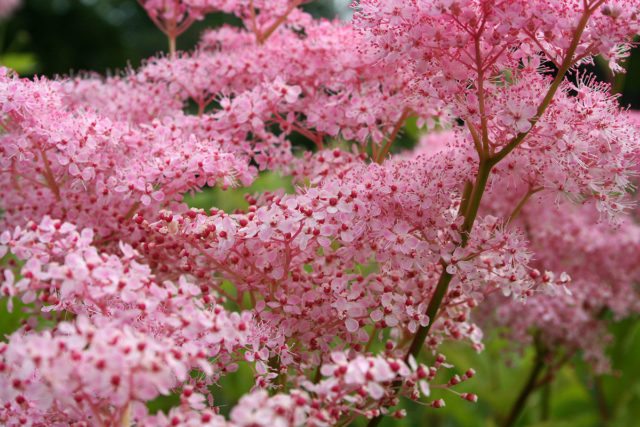
Delicate lace of pink meadowsweet flowers fills the air with an inviting honey-vanilla aroma
Planting and caring for pink meadowsweet
Pink meadowsweet (meadowsweet) is an unpretentious culture that successfully grows and develops without much human intervention. Knowing the basic rules of planting and care, you can grow chic pink meadowsweet bushes, which adorn the surrounding area with endless flowering all summer.
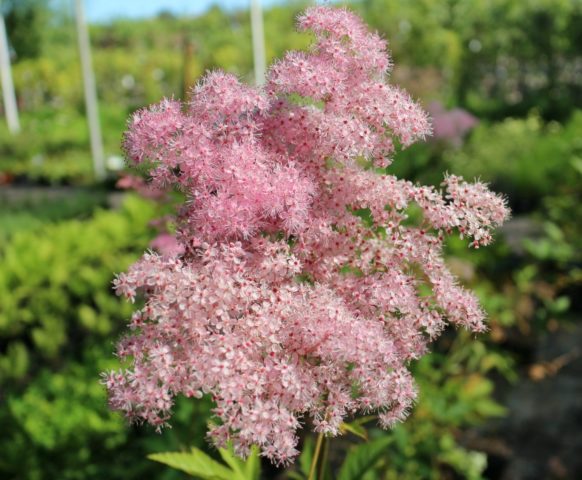
Tavolga annually produces flower stalks, subject to the correct choice of location
Landing dates
When choosing bushes or root plots of pink meadowsweet in nurseries or specialized stores, it should be remembered that perennial plants can most easily endure autumn or spring planting. The period of adaptation and engraftment of the root system is more successful in the cool season.
Site and soil requirements
Experienced gardeners recommend paying special attention to the selection of the location for the pink meadowsweet. Abundant, long-term, annual flowering is guaranteed with the right choice of the site:
- open, well-lit areas or areas of the garden with little shade;
- a thick drainage layer, provided that groundwater is close;
- close proximity to marshlands, artificial or natural reservoirs.
Pink decorative meadowsweet (meadowsweet) prefers neutral, non-acidic, nutritious, loose, permeable, abundantly moist soil. When preparing planting holes, you can add wood ash or lime to neutralize high acidity, as well as add river sand, natural humus or compost.
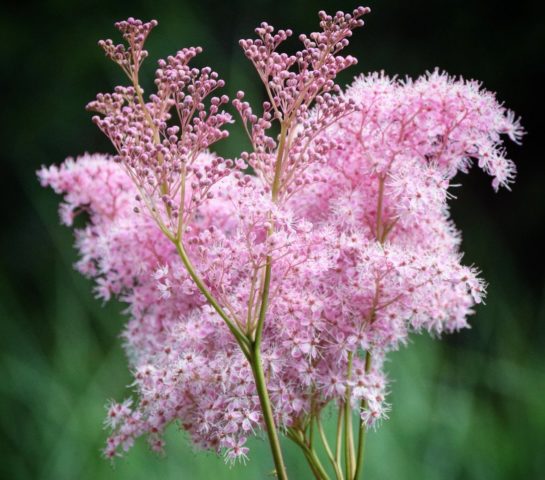
In conditions of absolute shading, ornamental honey plant "refuses" to bloom
Planting and aftercare
Meadowsweet (meadowsweet) pink can multiply by seed and vegetative methods (dividing part of the rhizome or bush). Planting plots is one of the most popular methods for growing perennials.
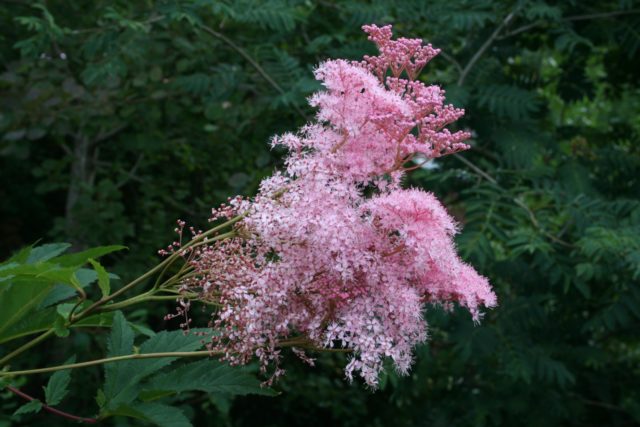
The division of the bush and rhizomes allows you to fully preserve the varietal characteristics of an ornamental plant
Planting from seeds
Rose garden meadowsweet (meadowsweet) can be grown from seeds harvested at home or purchased from specialized stores. Perennial seeds remain viable for 5-6 years. Seed propagation has its own difficulties, since the meadowsweet seed is highly sensitive to light. For this reason, seeds are sown in shaded areas, and as they grow, they are moved to a permanent place.
The seed is placed in the ground before winter. This technique of agricultural technology allows for natural hardening and stratification.
Algorithm for sowing seeds in the ground:
- time - October-November;
- the site is cleared of weeds;
- moisten the soil abundantly;
- the seeds are buried up to 5 cm;
- planting scheme - 30 x40 cm.
Pink meadowsweet, like other varieties of perennial meadowsweet, when grown from seeds, is characterized by slow growth and development. The first shoots appear only at the beginning of May. By the end of the growing season, 4-5 leaves are formed on young plants. Flowering occurs in 2-3 years of life.
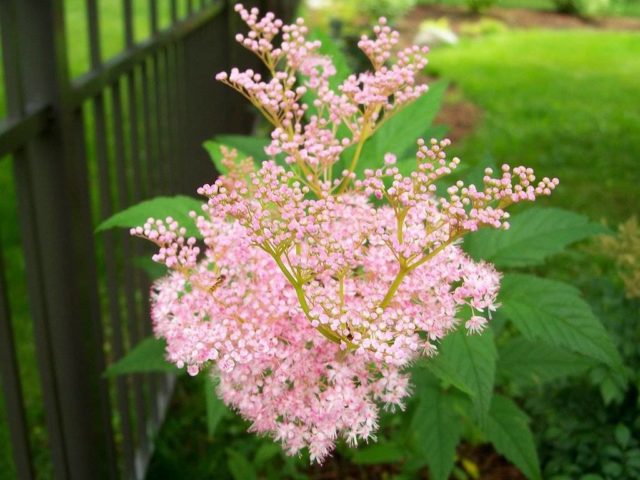
Spring sowing of meadowsweet seeds in open ground is not always successful, therefore experienced florists recommend sowing work before winter
Planting plots
Dividing the pink meadowsweet bush is best done in the autumn, after the end of flowering. You can transplant plots yourself in early spring (March-April). Plants grown in this way will begin to delight with flowering much later than those bushes that were planted in open ground before winter.
Algorithm for planting plots of pink meadowsweet:
- the mother bush is completely dug out of the ground;
- the root system, together with the ground part, is divided using sharp garden tools;
- the places of the cuts are treated with wood ash;
- plots are placed in open ground immediately to prevent root winding;
- the distance between the plots is more than 50 cm;
- the depth of the landing holes - up to 5 cm;
- drainage is placed at the bottom of the landing hole;
- the well is abundantly moistened;
- the root system is placed horizontally, the buds should be directed upward.
The pink decorative meadowsweet is a rather aggressive culture. Adult bushes can "hammer" the nearest neighbors, quickly spreading and occupying all the free space.
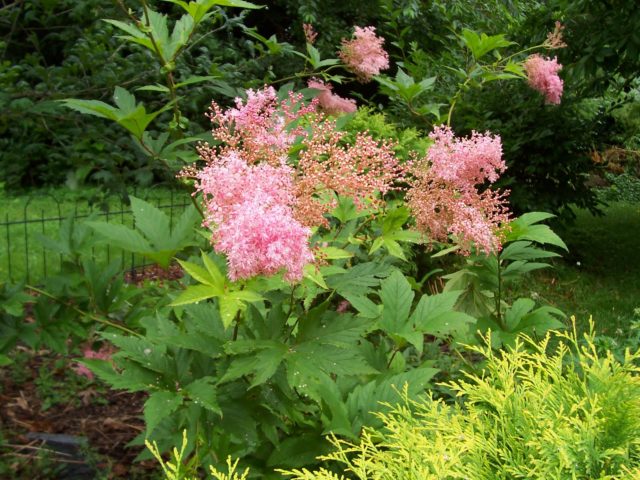
Tavolga can be placed in a large container or limit the planting hole with non-woven material, roofing material
Follow-up care
The most difficult period for a pink garden meadowsweet (meadowsweet) is dry summer days. During this period, meadowsweet bushes require additional watering. Despite the fact that the plant has established itself as a "water lover", pink meadowsweet does not tolerate stagnation of moisture in the root system. The culture feels comfortable in moist, but loose and oxygenated soil. In the conditions of European summer, a decorative garden perennial needs universal care:
- watering at least 1 time per week;
- loosening the soil around the bushes with each watering to prevent stagnation;
- mulching to preserve moisture and protect horses from exposure;
- feeding with organic or mineral fertilizers (superphosphate, potassium sulfate) 1-2 times during the growing season;
- transplant with renewal of bushes - every 6-7 years;
- preparation for wintering, autumn pruning of shoots (frost-resistant bushes do not require shelter for the winter).
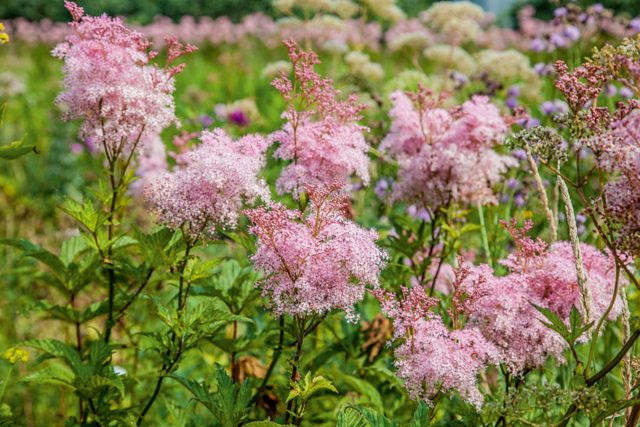
Since the root system of the pink-flowered meadowsweet (meadowsweet) grows intensively every year, it is necessary to periodically pour fertilized soil or organic mulch under the bush to prevent the complete exposure of the root system
Diseases and pests
Pink meadowsweet (meadowsweet), like other varieties of the elm-leaved species, exhibit stable immunity against pests and pathogens. In rare cases, with gross violations of the rules of care, a decorative perennial is infected with the following ailments:
- Powdery mildew, affects the hard leaf plates of pink meadowsweet. The disease is manifested by the presence of white bloom on the upper green part of the leaves. The spreading bush gradually withers, loses its gorgeous foliage, the intensity and duration of flowering decreases. Colloidal sulfur is used to prevent powdery mildew, as well as at an early stage of infection with a fungus.
Bushes of pink-flowered meadowsweet completely affected by powdery mildew should be dug up and burned, the planting site should be disinfected
- Rust - a fungal disease, the manifestation of which begins with gray, brown, brown spots on the basal foliage. Timely measures with the rapid detection of an ailment at an early stage can prevent the loss of the bush.
Copper sulfate, slaked lime, as well as modern fungicides - preparations that are convenient to use, allow you to effectively and quickly get rid of the manifestation of rust on the bushes of a pink garden meadowsweet
Due to weeds, insects can attack plants:
- Aphid Is a well-known sucking pest that lives in huge colonies on foliage and inflorescences of meadowsweet. The meadowsweet bushes affected by aphids lose their decorative appeal.
Folk remedies (spraying with tinctures of wormwood, tomato tops, tobacco, soap), along with universal insecticides, effectively eliminate insects on pink meadowsweet bushes
- Wireworm (Elateridae) is the larva of the click beetle. The pest feeds on the roots of the pink meadowsweet. As a result of damage to the underground part of the foliage and stems wither, the bush dies.
The most popular and inexpensive measure for the prevention and control of wireworms on pink meadowsweet bushes is the annual spring liming of the soil.
Meadowsweet pink in landscape design
Modern landscape decorators quite often use the undeservedly forgotten pink meadowsweet (meadowsweet) for garden decoration, local area, assigning various roles to the plant:
- decor of artificial reservoirs, landing along the perimeter, along the coastline;
- masking of walls, various architectural forms;
- hedge;
- delimitation of zones;
- in the background mixborders, prefabricated flower beds;
- in the foreground - against the background of trees or shrubs, other tall herbaceous perennials;
- for single author's plantings against the background of picturesque lawns, lawns;
- for group design compositions.
In the garden, pink-flowered meadowsweet can be planted next to hydrangea, dicenter, irises, lilies, astilbe, carnations, loosestrife, volzhanka, hosts, ferns. In the photo - pink meadowsweet in combination with other decorative perennials.
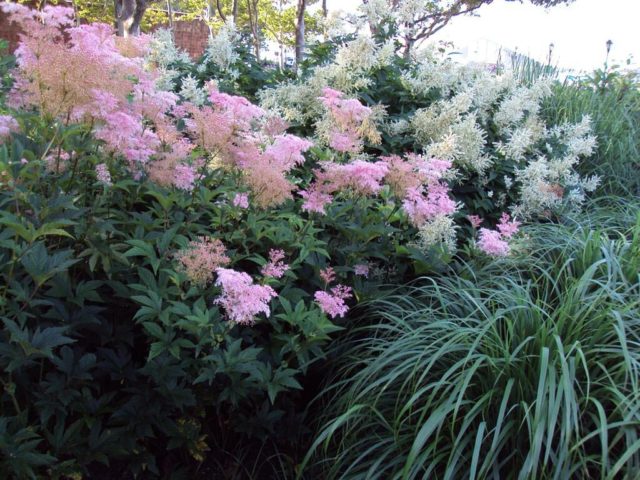
Blooming pink panicles of meadowsweet (meadowsweet) look beautiful next to white-flowering varieties of this culture
Conclusion
Pink meadowsweet is a perennial from the line of modern garden giants. Culture requires a minimum of attention to itself. At the same time, the exuberant flowering lasts about 1.5-2 months. The most problematic areas of the local area can be enveloped in a pink haze in order to hide old buildings, unaesthetic architectural forms. The plant needs sufficient sunlight and moderate watering.
